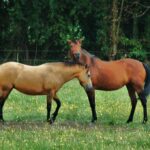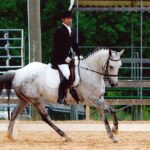Cross-country jumping is one of the most exhilarating and challenging equestrian disciplines, requiring a deep partnership between horse and rider. Unlike show jumping with its precisely measured distances and uniform obstacles, cross-country courses feature natural elements, varied terrain, and solid obstacles that demand confidence, athleticism, and problem-solving from both horse and human. Teaching a horse to navigate these courses successfully isn’t merely about physical training; it’s about building trust, developing judgment, and creating a brave, thinking equine partner. The following techniques represent proven methods for developing a horse that approaches cross-country fences with enthusiasm and skill, turning the potentially daunting challenge of natural obstacles into an engaging adventure for both horse and rider.
Establishing a Solid Flatwork Foundation

Before a horse ever sees its first cross-country jump, it must develop impeccable flatwork skills as the foundation for all future training. Balanced transitions, consistent rhythm, and responsiveness to aids create the control necessary for safe and effective jumping. Work on developing a forward-thinking horse that moves readily from your leg while maintaining self-carriage and balance through corners and straight lines. Pay particular attention to establishing half-halts that rebalance without sacrificing forward momentum, as this communication will become essential when approaching varied obstacles at speed. Remember that a horse that truly understands leg, seat, and hand aids while moving on the flat will be significantly easier to direct and control when navigating a cross-country course.
Introducing Small Natural Obstacles

The transition from arena jumping to cross-country obstacles should begin with simple, natural elements that don’t exceed 18 inches in height. Logs, small banks, and shallow water crossings provide perfect introductory challenges that familiarize horses with the concept of natural fences without overwhelming them. Present these obstacles during regular hacks or trail rides rather than formal training sessions to keep the experience relaxed and positive. Approach each introduction with a confident, matter-of-fact attitude, as horses quickly sense hesitation or concern from their riders. Use experienced companion horses when possible, as many horses gain confidence from following a trusted leader through new challenges before attempting them independently.
Developing Forward Momentum

Cross-country jumping relies fundamentally on forward, positive momentum that carries horse and rider safely over solid obstacles. Unlike show jumping where collection and careful measurement often predominate, cross-country requires teaching the horse to maintain an energetic, ground-covering pace that builds confidence and safety. Practice transitions between working, medium, and extended gaits to develop the horse’s understanding of moving forward from subtle leg aids without rushing or hollowing. Create exercises where the horse must maintain the same rhythm while covering more ground, helping them understand how to adjust their stride length without changing tempo. This forward thinking becomes crucial when approaching obstacles that require significant power, such as uphill combinations or wide ditches.
Building Trust Through Gymnastics

Gymnastic jumping exercises create a methodical approach to building the horse’s confidence over varied obstacles while developing necessary physical skills. Begin with simple pole exercises on the ground before progressing to small cavaletti in patterns that teach the horse to assess distances and adjust their stride accordingly. Gradually introduce more complex arrangements with small crossrails leading to verticals or simple oxers, always maintaining distances that encourage forward, confident movement. Keep sessions short and positive, ending each exercise before the horse shows signs of mental or physical fatigue. The primary goal of gymnastics is developing a horse that approaches fences willingly and problem-solves rather than one that simply memorizes specific distances or patterns.
Training for Varied Terrain

Cross-country courses feature significantly more terrain variation than arena jumping, requiring horses to develop balance and coordination on hills, depressions, and uneven ground. Dedicate training time to walking, trotting, and eventually cantering on varied terrain without jumps to build the horse’s proprioception and confidence. Practice transitions while moving uphill and downhill to develop the horse’s ability to shift their balance appropriately without losing impulsion. Introduce simple ground poles on slopes before progressing to small jumps on varied terrain, always ensuring the horse feels secure and balanced before increasing difficulty. Remember that terrain introduces an additional challenge to jumping, so reduce obstacle size when initially combining jumps with significant terrain changes.
Mastering Water Complexes

Water obstacles represent one of the most common challenges for cross-country horses, requiring specific, systematic training to develop confidence. Begin with simple water crossings during trail rides, allowing the horse to investigate shallow water with a relaxed attitude before expecting forward movement through it. Progress to walking through progressively deeper water, then trotting and eventually cantering through established water complexes with firm, known footing. Once comfortable moving through water, introduce simple entries and exits over small steps or slopes, being careful not to rush this progression. Advanced training includes practicing jumps that land in water or require taking off from water, but these should only be attempted after the horse demonstrates complete comfort with basic water navigation.
Developing Confidence Over Ditches

Ditches trigger many horses’ natural instinct to stop and investigate before crossing, making systematic training essential for developing confident responses. Begin with walking over ground poles or very shallow depressions to establish the concept of moving forward over changes in the ground. Progress to small, clearly defined ditches with guide rails if needed, focusing on maintaining a consistent rhythm and forward attitude in the approach. Reward immediate success lavishly, and if hesitation occurs, return to a previous successful level rather than escalating pressure. Gradually increase ditch width only after the horse consistently demonstrates confidence at the current level, remembering that width often proves more challenging than depth for many horses.
Teaching Technical Combinations

Advanced cross-country courses feature technical combinations requiring horses to navigate multiple elements in succession, often with terrain changes between obstacles. Develop your horse’s ability to handle these challenges by initially setting simple related distances on flat ground with easily navigable obstacles. Progress to more complex arrangements where the horse must adjust stride length or navigate a turn between elements while maintaining forward impulsion. Practice “coffin” combinations (ditch preceded or followed by vertical elements) and step combinations at small heights before gradually increasing the challenge. The goal is developing a horse that can land from one element already organized and thinking about the next, rather than needing significant reorganization between fences.
Building Appropriate Fitness

Cross-country jumping demands significant cardiovascular fitness and muscular endurance from horses, requiring a systematic conditioning program alongside technical training. Develop a progressive fitness plan that includes long, slow distance work to build aerobic capacity, interspersed with interval training to improve anaerobic threshold and recovery. Include hill work to develop hindquarter strength essential for jumping efforts, particularly for ascending obstacles or combinations requiring significant propulsion. Monitor vital signs during conditioning to ensure appropriate progression without overtraining, paying particular attention to recovery rates after exertion. Remember that physical fatigue significantly impacts judgment and coordination, making proper fitness essential not just for performance but for safety across the course.
Understanding Psychological Preparation

Successful cross-country horses require specific psychological training beyond physical preparation, developing mental traits that support confident problem-solving. Create training scenarios that reward thinking and assessment rather than just obedience, teaching horses to evaluate obstacles rather than simply responding to rider commands. Incorporate varied environments in training to develop adaptability, gradually exposing horses to crowds, loudspeakers, and other competition elements they’ll encounter at events. Practice recovering from minor mistakes or hesitations productively, teaching the horse that a momentary uncertainty doesn’t need to escalate into refusal. This psychological resilience becomes crucial when encountering unexpected challenges on course, such as changing light conditions or unusual jump decorations.
Simulating Competition Environments

The transition from training to competition presents significant challenges for many horses, making simulation an important training technique. Create mock competition scenarios by setting up multiple obstacles in sequence and riding them with minimal preparation between efforts, simulating the continuous nature of cross-country courses. Arrange training outings to unfamiliar venues with different jumps and environments to develop adaptability before actual competition. Incorporate pre-competition routines into training days, including trailer loading, warmup patterns, and equipment adjustments to familiarize the horse with the full competition experience. When possible, participate in schooling days at actual competition venues, allowing horses to experience specific courses in a lower-pressure environment before competing.
Troubleshooting Common Issues

Even well-trained horses may develop specific concerns with certain cross-country elements, requiring targeted intervention. For horses that rush fences, develop exercises emphasizing rhythm maintenance through ground pole patterns before and after small jumps, gradually rebuilding calm, methodical approaches. Address stopping or hesitation by returning to significantly smaller versions of problematic obstacles, focusing on forward momentum and confidence building rather than the specific obstacle dimensions. For horses that become overly excited on course, incorporate pattern work and changes of direction between fences to maintain focus and responsiveness to aids. Remember that regression to earlier training stages is often more effective than repetition or increased pressure when addressing confidence issues.
Creating a Progressive Training Schedule

Long-term success in cross-country jumping requires thoughtful scheduling that balances technical training, fitness work, and mental freshness. Develop a periodized training plan that includes focused skill development phases alternating with consolidation periods where newly acquired skills become reliable habits. Schedule regular “mental health” days featuring relaxed hacking or different activities to prevent monotony and maintain enthusiasm. Carefully plan competition progression to ensure horses experience appropriate challenges without facing overwhelming technical questions before they’ve developed necessary skills and confidence. Remember that cross-country development typically takes significantly longer than arena jumping proficiency, often requiring several seasons of systematic progression for horses to reach advanced levels confidently.
Conclusion

Developing a cross-country jumper requires patience, systematic training, and deep understanding of equine psychology alongside technical expertise. The most successful training programs prioritize building a horse’s confidence and problem-solving abilities while gradually developing the physical skills necessary for safe navigation of challenging terrain and obstacles. By focusing on thorough groundwork, progressive introduction to natural elements, and systematic building of both physical and mental capabilities, riders can develop partners that approach cross-country courses with enthusiasm and skill. The joy of galloping across country on a confident, capable horse represents the ultimate reward for this methodical training journey, creating a partnership tested and strengthened through shared adventures and challenges overcome together.







